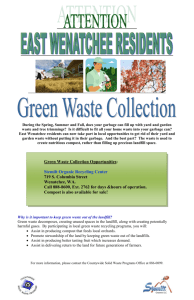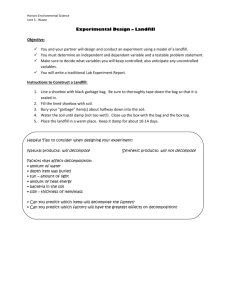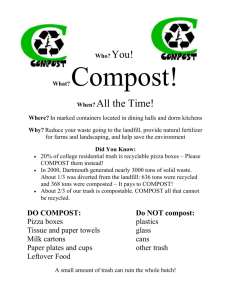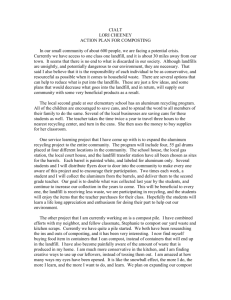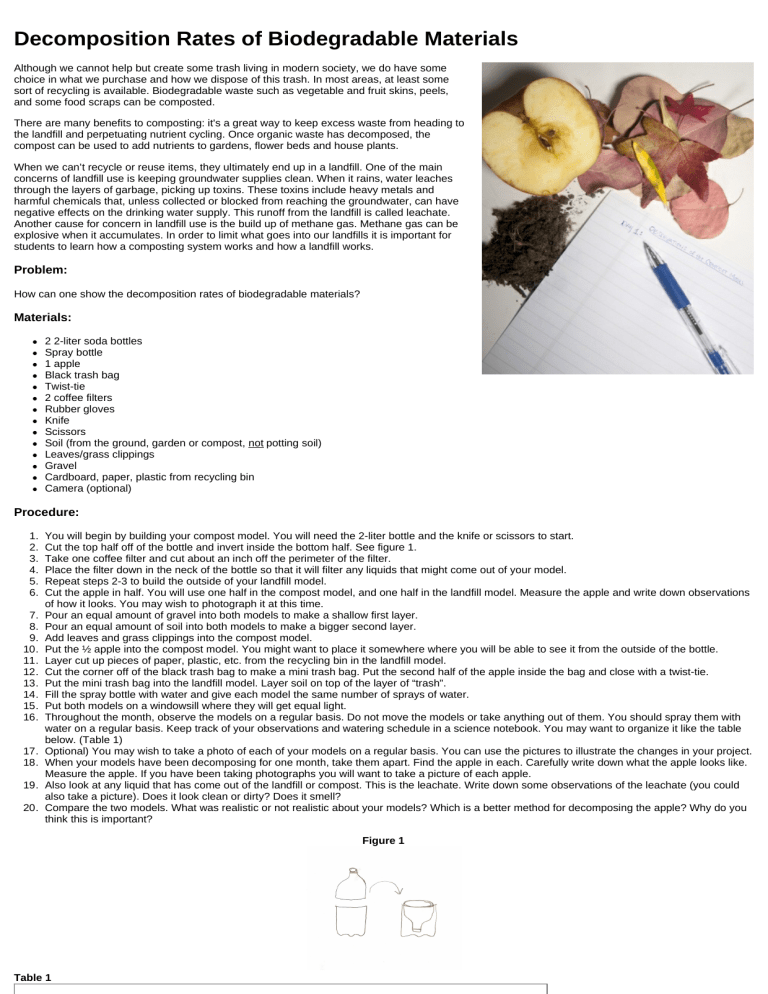
Decomposition Rates of Biodegradable Materials Although we cannot help but create some trash living in modern society, we do have some choice in what we purchase and how we dispose of this trash. In most areas, at least some sort of recycling is available. Biodegradable waste such as vegetable and fruit skins, peels, and some food scraps can be composted. There are many benefits to composting: it's a great way to keep excess waste from heading to the landfill and perpetuating nutrient cycling. Once organic waste has decomposed, the compost can be used to add nutrients to gardens, flower beds and house plants. When we can’t recycle or reuse items, they ultimately end up in a landfill. One of the main concerns of landfill use is keeping groundwater supplies clean. When it rains, water leaches through the layers of garbage, picking up toxins. These toxins include heavy metals and harmful chemicals that, unless collected or blocked from reaching the groundwater, can have negative effects on the drinking water supply. This runoff from the landfill is called leachate. Another cause for concern in landfill use is the build up of methane gas. Methane gas can be explosive when it accumulates. In order to limit what goes into our landfills it is important for students to learn how a composting system works and how a landfill works. Problem: How can one show the decomposition rates of biodegradable materials? Materials: 2 2-liter soda bottles Spray bottle 1 apple Black trash bag Twist-tie 2 coffee filters Rubber gloves Knife Scissors Soil (from the ground, garden or compost, not potting soil) Leaves/grass clippings Gravel Cardboard, paper, plastic from recycling bin Camera (optional) Procedure: 1. 2. 3. 4. 5. 6. 7. 8. 9. 10. 11. 12. 13. 14. 15. 16. 17. 18. 19. 20. You will begin by building your compost model. You will need the 2-liter bottle and the knife or scissors to start. Cut the top half off of the bottle and invert inside the bottom half. See figure 1. Take one coffee filter and cut about an inch off the perimeter of the filter. Place the filter down in the neck of the bottle so that it will filter any liquids that might come out of your model. Repeat steps 2-3 to build the outside of your landfill model. Cut the apple in half. You will use one half in the compost model, and one half in the landfill model. Measure the apple and write down observations of how it looks. You may wish to photograph it at this time. Pour an equal amount of gravel into both models to make a shallow first layer. Pour an equal amount of soil into both models to make a bigger second layer. Add leaves and grass clippings into the compost model. Put the ½ apple into the compost model. You might want to place it somewhere where you will be able to see it from the outside of the bottle. Layer cut up pieces of paper, plastic, etc. from the recycling bin in the landfill model. Cut the corner off of the black trash bag to make a mini trash bag. Put the second half of the apple inside the bag and close with a twist-tie. Put the mini trash bag into the landfill model. Layer soil on top of the layer of “trash”. Fill the spray bottle with water and give each model the same number of sprays of water. Put both models on a windowsill where they will get equal light. Throughout the month, observe the models on a regular basis. Do not move the models or take anything out of them. You should spray them with water on a regular basis. Keep track of your observations and watering schedule in a science notebook. You may want to organize it like the table below. (Table 1) Optional) You may wish to take a photo of each of your models on a regular basis. You can use the pictures to illustrate the changes in your project. When your models have been decomposing for one month, take them apart. Find the apple in each. Carefully write down what the apple looks like. Measure the apple. If you have been taking photographs you will want to take a picture of each apple. Also look at any liquid that has come out of the landfill or compost. This is the leachate. Write down some observations of the leachate (you could also take a picture). Does it look clean or dirty? Does it smell? Compare the two models. What was realistic or not realistic about your models? Which is a better method for decomposing the apple? Why do you think this is important? Figure 1 Table 1 Observations Date Compost Model Watering Schedule Date # of Sprays Compost Model Landfill Model Landfill Model Author: Sarah Benton Copyright © 2022 Education.com LLC All Rights Reserved

